What to do if my Apex Digital AD-1100W DVD Player has no power?
- AAngela MillerAug 16, 2025
Ensure the power plug is securely connected to the wall outlet.
What to do if my Apex Digital AD-1100W DVD Player has no power?
Ensure the power plug is securely connected to the wall outlet.
What to do if my Apex Digital AD-1100W DVD Player has no sound?
First, ensure the audio cables are securely connected into the jacks. Next, check the connection from the DVD audio output to the TV or receiver audio input and switch to the correct source on your receiver. Consult your audio amplifier's manual for specific instructions.
Why does my Apex Digital AD-1100W DVD Player have no picture?
Verify the connection from the DVD video output to the TV video input, then switch your TV to the appropriate mode (video 1). Also, make sure the video cable is securely connected into the jacks. Refer to your television owner's manual for guidance.
What to do if my Apex Digital AD-1100W does not start playback?
Here are some things to check if your Apex Digital DVD player isn't playing: 1. Ensure the disc is placed with the graphics side up. 2. Make sure the disc is correctly placed on the disc tray inside the guide. 3. Check that the disc is free from scratches and fingerprints. 4. Press the SETUP button to turn off the menu screen. 5. Cancel the parental lock function or change the parental lock level (the default password is 3308). 6. Turn the power off, disconnect the power plug, reinsert it into the wall, and try again. 7. Use region 1 discs only.
Why is the brightness unstable or are there noises on playback pictures from my Apex Digital DVD Player?
Connect the DVD player directly to the TV, bypassing any other source. This issue can be due to the copy protection circuitry present in all DVD players. If your TV lacks a video input, you'll need to purchase an RF adapter from a dealer.
What to do if my Apex Digital AD-1100W DVD Player's remote control does not work properly?
Replace the batteries in the remote control with new ones.
Why is my Apex Digital AD-1100W DVD Player showing a rolling black and white picture?
Try pressing the P/N button on your remote control. If that doesn't work, adjust the vertical hold on your TV.
Why is my Apex Digital AD-1100W DVD Player showing a black and white picture?
The black and white picture may be caused by a damaged S connector (bent pin).
Why does the playback picture on my Apex Digital DVD Player have occasional distortion?
A small amount of picture distortion can occur due to poor video/sound transfer to the disc, especially on discs manufactured between 1997-1998. Another cause could be a scratched disc.
Why won't my Apex Digital DVD Player read or skips MP3 discs?
Reburn the disc, as the software edition used may not be compatible with the player. Use new editions of software such as Voyetra Audiostation 4, Adaptec’s “Easy CD Creator” or NTI, Roxio’s Toast Titanium, etc. Also, ensure that MP3 files are not encoded with a variable bit rate such as provided by Real Networks.
| Brand | Apex Digital |
|---|---|
| Model | AD-1100W |
| Category | DVD Player |
| Language | English |
Explains symbols like lightning flash and exclamation point for user safety warnings.
Warns against exposing the appliance to rain/moisture and opening the enclosure due to high voltage.
Advises against direct laser beam exposure and opening the enclosure to prevent radiation exposure.
States compliance with Class B digital device limits for residential interference.
Informs about the player's region code and disc compatibility.
Section for the customer to record model and serial numbers for future reference.
Emphasizes reading, following, retaining, and heeding all safety and operating instructions.
Covers cleaning methods, approved attachments, and proper ventilation for product longevity.
Details power supply types, grounding/polarization plugs, and cord protection.
Addresses water/moisture, ventilation, heat sources, and object/liquid entry precautions.
Stresses using qualified personnel for servicing and specifying correct replacement parts.
Lists items included in the DVD player accessory package and instructions for damaged/missing items.
Guides on placing the unit on a firm, flat surface away from magnetic flux sources for best performance.
Recommends regular inspection and maintenance of optical pick-up lens and drive parts for optimal picture clarity.
Advises against touching playback side, attaching paper/tape, and warns about potential damage from player operation.
Details how to clean discs using a soft cloth and warns against using solvents or cleaners.
Provides recommendations for storing discs away from sunlight, heat, moisture, and dust to prevent warping.
Lists the types of discs playable by the DVD video player, including DVD, CD Audio, MP3 CD, and Kodak Picture CD.
Explains DVD region codes and confirms the player supports Region 1 DVDs.
Specifies that the player is compatible with NTSC or PAL/3.58 TV systems.
Identifies and describes the function of buttons on the front panel of the DVD player.
Lists and describes the various output and input ports located on the rear panel of the unit.
Details the functions of each button on the remote control and their corresponding page numbers.
Provides important notes on power, shift key usage, mute function, menu access, and volume control via TV.
Step-by-step instructions for opening the cover, inserting AA batteries, and closing the cover.
Explains the need to point the remote at the sensor, distance/angle limits, and avoiding direct sunlight.
Diagrams and instructions for connecting via standard RCA (composite) cables for video and audio.
Explains how to connect using an S-Video cable for improved picture quality, noting not to use the yellow video cable simultaneously.
Explains the need for an RF modulator for older TVs and its function in signal conversion.
Provides a diagram and steps for connecting the DVD player to a TV using an RF modulator.
Details the connection steps for linking the DVD player, RF modulator, and TV through a cable or satellite box.
Outlines the wiring for a complex setup involving DVD, VCR, cable/satellite box, and TV via an RF modulator.
Guides on connecting an amplifier and speaker system for immersive surround sound experiences.
Explains how to connect an amplifier with a digital audio input for clear digital stereo sound.
Describes connecting to a Dolby Digital/DTS receiver for multi-channel surround sound.
Instructs on configuring the 'AUDIO OUTPUT' setting in the menu to 'SPDIF/RAW' for digital audio.
Defines MP3 as a music file format popular for internet downloads, playable on the unit.
Explains Picture CD, including Kodak Picture CDs, for viewing photos on TV.
Details how to play MP3 files, select playback modes, and navigate through songs and folders.
Describes the automated slideshow feature and available transition modes for Picture CDs.
Explains how to rotate displayed images using direction keys for Invert, Mirror, Left, and Right transformations.
Details how to repeat the slideshow and use the MENU key to view thumbnail pictures.
Outlines turning on the TV/audio system, selecting input sources, and basic playback initiation.
Guides on placing discs on the tray, ensuring correct orientation, and starting playback with ENTER/PLAY.
Suggests reducing TV sharpness for better DVD picture quality and managing playback artifacts.
Explains how DVD and CD icons appear and how to use Fast Forward/Reverse controls.
Covers starting playback from menus, pausing, resuming, stopping, and removing discs.
Details how to play discs at 2x, 4x, 6x, or 8x normal speed using REV/FWD buttons.
Explains how to advance playback one frame at a time using the STEP button.
Describes playing discs in slow-motion at 1/2, 1/4, or 1/8 speed using the SLOW button.
Explains how to stop playback and resume from the same location, and actions that cancel this feature.
Guides on using the title menu and number buttons to select specific titles for playback.
Details using SKIP buttons to find preceding or succeeding chapters and tracks on a disc.
Explains how to use the GOTO button and number keys to directly select a specific title or chapter.
Describes how to set and initiate random playback of titles, chapters, or tracks.
Explains how to set repeat modes for titles, chapters, or tracks using the REPEAT button.
Details how to zoom into a picture and shift the zoom point using the ZOOM and direction keys.
Instructs on how to resume normal playback from zoom mode by pressing the ZOOM button again.
Explains how to select different camera angles during playback when available.
Guides on choosing preferred language and sound recording systems included on the disc.
Details how to program up to 99 titles, chapters, or tracks in a custom playback order.
Provides instructions on how to change or cancel a programmed playback sequence.
Explains how to select preferred subtitles from those included on the DVD video disc using the SUB-T button.
Guides on how to turn off subtitles by repeatedly pressing the SUB-T button until they disappear.
Defines JPEG as a standard for continuous tone image coding, suitable for photos and graphics.
Provides steps on using computer software to create and save image files in JPEG format.
Describes how to play JPEG files as a slideshow with various transition modes.
Explains image rotation options and how to zoom into pictures using the player's controls.
Details using the MENU key to display thumbnail pictures and select individual images.
Explains how to display current title, track number, and playing time on the TV screen.
Instructs on how to turn off the on-screen display by pressing the DISPLAY button again.
Explains that DVD discs are rated and can be controlled by parental lock levels for content suitability.
Guides on how to access the parental lock settings via the SETUP menu and enter the default password.
Describes how to select categories like General, Speaker, Dolby Digital, and Preferences in the SETUP MENU.
Details various settings available within the menu, such as TV display, audio output, and language preferences.
Lists technical details of the player, including power, dimensions, laser type, and video/audio outputs.
Enumerate the items included with the DVD player, such as cables, remote, and batteries.
Details sound recording systems and audio settings for DVD Video Discs, CD, and MP3 CDs.
Provides solutions for issues like no power, no picture, or rolling black and white pictures.
Offers fixes for no sound, picture distortion, unstable brightness, and playback errors.
Addresses problems with MP3 discs not reading or skipping, and the remote control not functioning properly.
Outlines what is covered (parts, labor) and what is excluded from the warranty.
Provides instructions for requesting service, contact details, and website for FAQs and updates.
Information on how to purchase accessories like remote controls and owner's manuals.
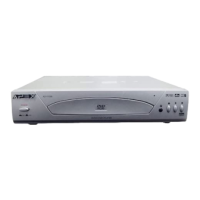

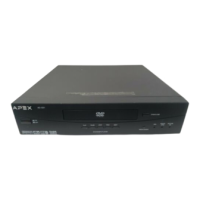

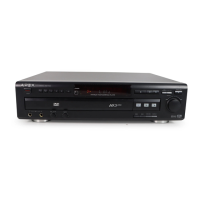
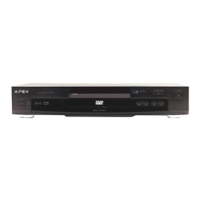
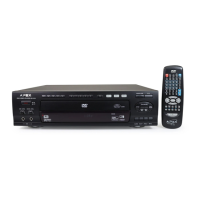
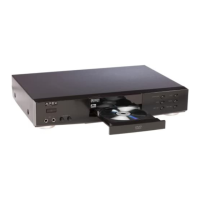
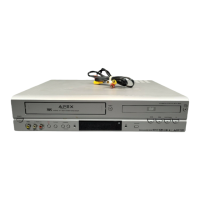
